Indigenous Health Report
VerifiedAdded on 2020/03/02
|9
|1938
|271
Report
AI Summary
This report examines the health and success rates of Aboriginal Australians, particularly those with mixed heritage. It discusses the historical context of social discrimination faced by Indigenous peoples in Australia, the advantages of mixed heritage in terms of education and job opportunities, and the challenges of cultural identity. The report highlights the importance of social inclusion and the need for effective policies to address the ongoing issues of discrimination and health disparities within Aboriginal communities.
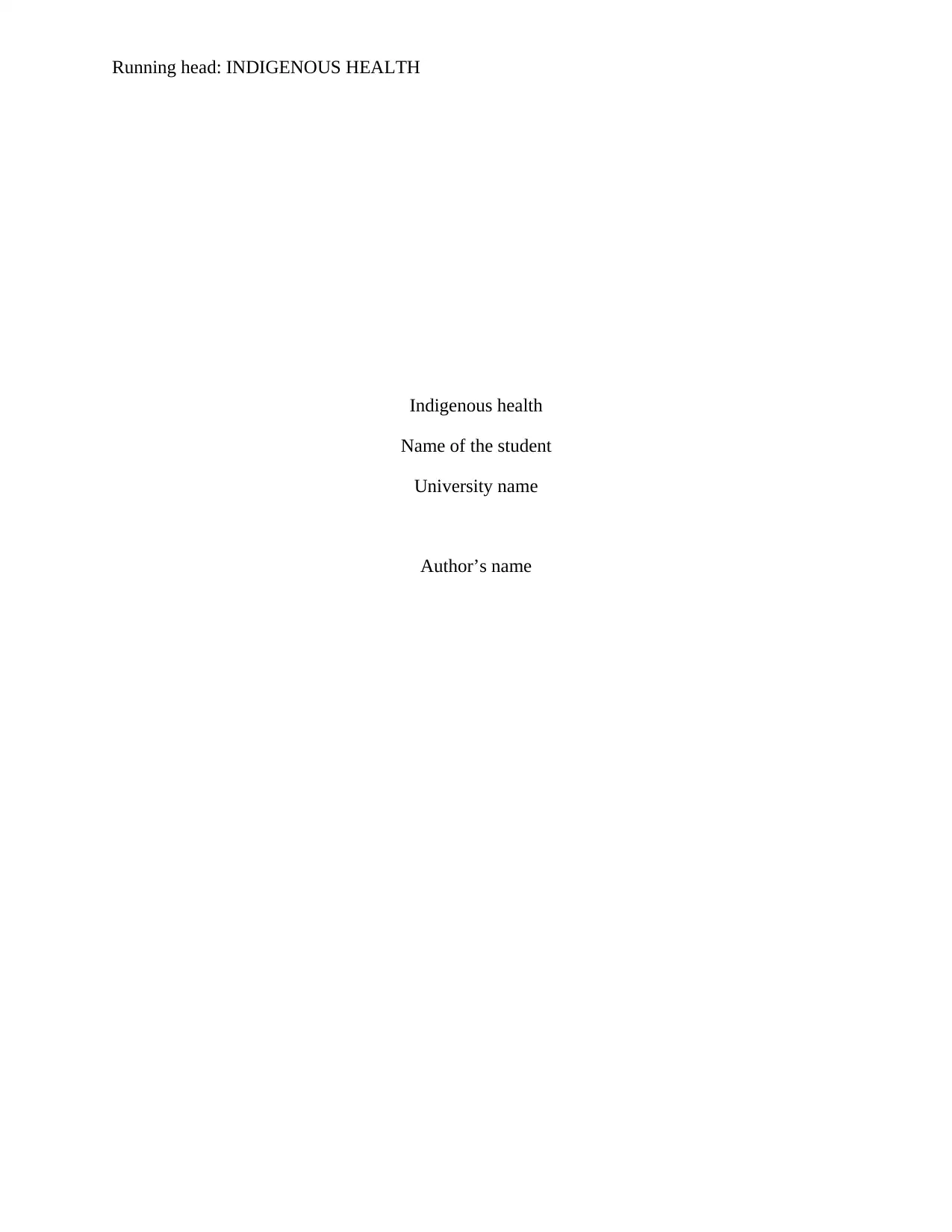
Running head: INDIGENOUS HEALTH
Indigenous health
Name of the student
University name
Author’s name
Indigenous health
Name of the student
University name
Author’s name
Paraphrase This Document
Need a fresh take? Get an instant paraphrase of this document with our AI Paraphraser
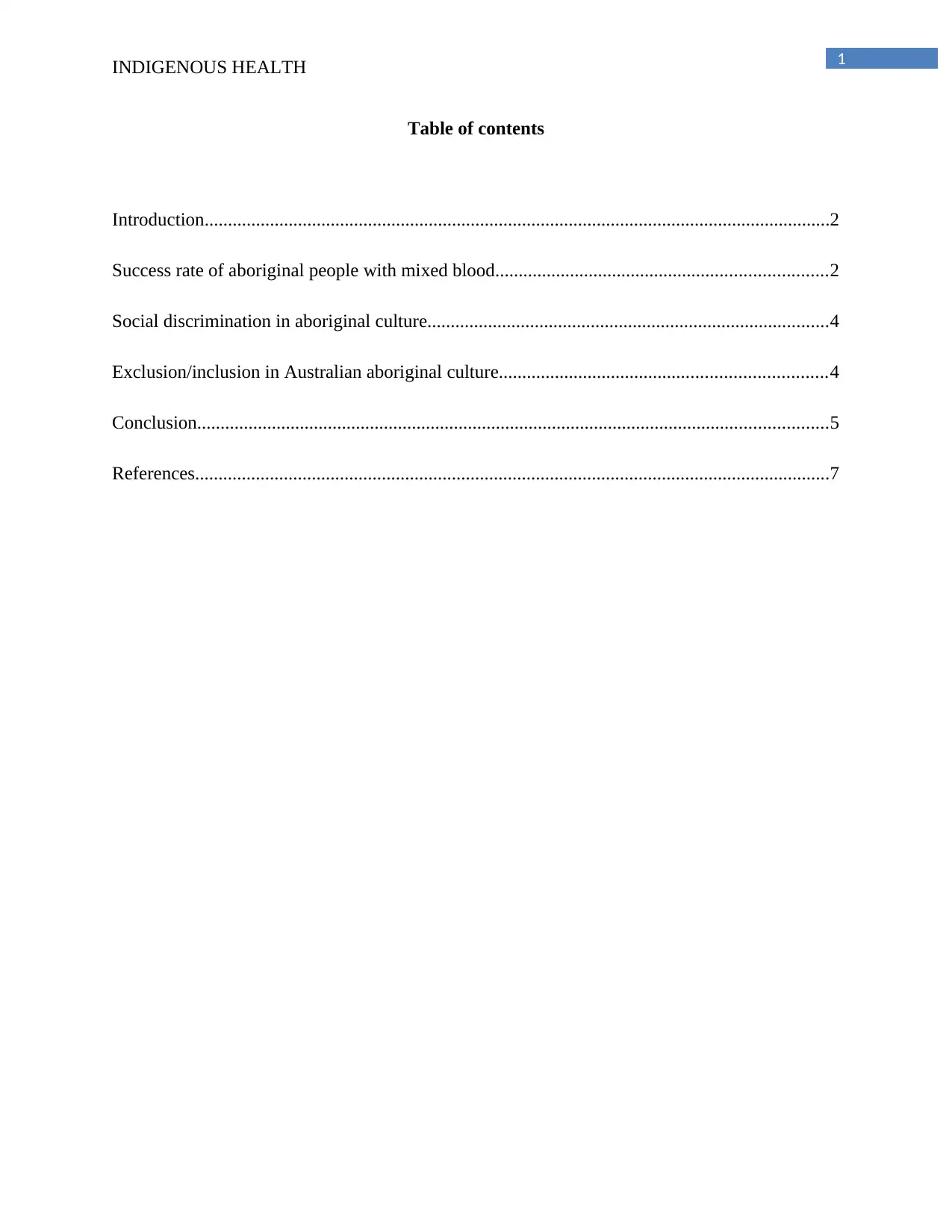
1INDIGENOUS HEALTH
Table of contents
Introduction......................................................................................................................................2
Success rate of aboriginal people with mixed blood.......................................................................2
Social discrimination in aboriginal culture......................................................................................4
Exclusion/inclusion in Australian aboriginal culture......................................................................4
Conclusion.......................................................................................................................................5
References........................................................................................................................................7
Table of contents
Introduction......................................................................................................................................2
Success rate of aboriginal people with mixed blood.......................................................................2
Social discrimination in aboriginal culture......................................................................................4
Exclusion/inclusion in Australian aboriginal culture......................................................................4
Conclusion.......................................................................................................................................5
References........................................................................................................................................7
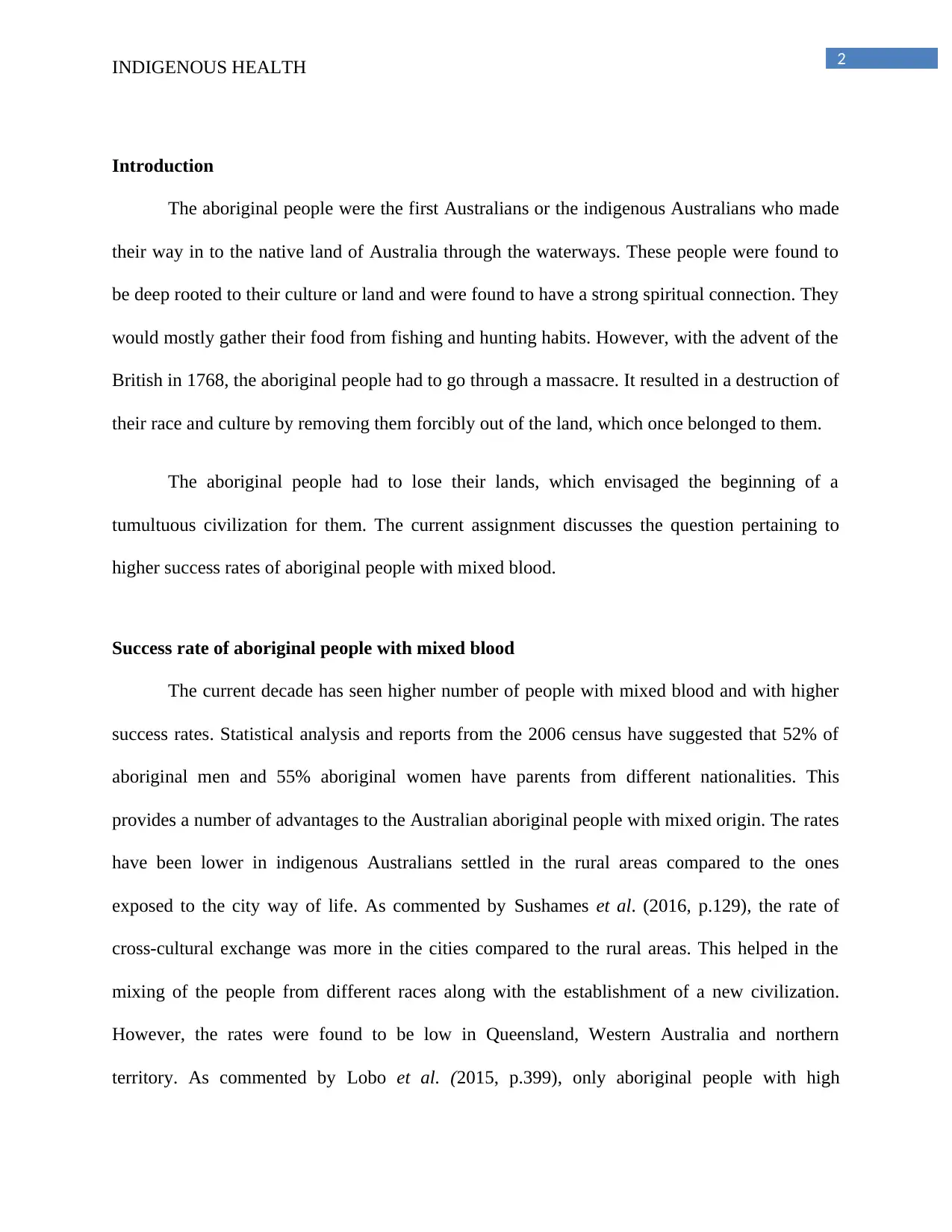
2INDIGENOUS HEALTH
Introduction
The aboriginal people were the first Australians or the indigenous Australians who made
their way in to the native land of Australia through the waterways. These people were found to
be deep rooted to their culture or land and were found to have a strong spiritual connection. They
would mostly gather their food from fishing and hunting habits. However, with the advent of the
British in 1768, the aboriginal people had to go through a massacre. It resulted in a destruction of
their race and culture by removing them forcibly out of the land, which once belonged to them.
The aboriginal people had to lose their lands, which envisaged the beginning of a
tumultuous civilization for them. The current assignment discusses the question pertaining to
higher success rates of aboriginal people with mixed blood.
Success rate of aboriginal people with mixed blood
The current decade has seen higher number of people with mixed blood and with higher
success rates. Statistical analysis and reports from the 2006 census have suggested that 52% of
aboriginal men and 55% aboriginal women have parents from different nationalities. This
provides a number of advantages to the Australian aboriginal people with mixed origin. The rates
have been lower in indigenous Australians settled in the rural areas compared to the ones
exposed to the city way of life. As commented by Sushames et al. (2016, p.129), the rate of
cross-cultural exchange was more in the cities compared to the rural areas. This helped in the
mixing of the people from different races along with the establishment of a new civilization.
However, the rates were found to be low in Queensland, Western Australia and northern
territory. As commented by Lobo et al. (2015, p.399), only aboriginal people with high
Introduction
The aboriginal people were the first Australians or the indigenous Australians who made
their way in to the native land of Australia through the waterways. These people were found to
be deep rooted to their culture or land and were found to have a strong spiritual connection. They
would mostly gather their food from fishing and hunting habits. However, with the advent of the
British in 1768, the aboriginal people had to go through a massacre. It resulted in a destruction of
their race and culture by removing them forcibly out of the land, which once belonged to them.
The aboriginal people had to lose their lands, which envisaged the beginning of a
tumultuous civilization for them. The current assignment discusses the question pertaining to
higher success rates of aboriginal people with mixed blood.
Success rate of aboriginal people with mixed blood
The current decade has seen higher number of people with mixed blood and with higher
success rates. Statistical analysis and reports from the 2006 census have suggested that 52% of
aboriginal men and 55% aboriginal women have parents from different nationalities. This
provides a number of advantages to the Australian aboriginal people with mixed origin. The rates
have been lower in indigenous Australians settled in the rural areas compared to the ones
exposed to the city way of life. As commented by Sushames et al. (2016, p.129), the rate of
cross-cultural exchange was more in the cities compared to the rural areas. This helped in the
mixing of the people from different races along with the establishment of a new civilization.
However, the rates were found to be low in Queensland, Western Australia and northern
territory. As commented by Lobo et al. (2015, p.399), only aboriginal people with high
⊘ This is a preview!⊘
Do you want full access?
Subscribe today to unlock all pages.

Trusted by 1+ million students worldwide
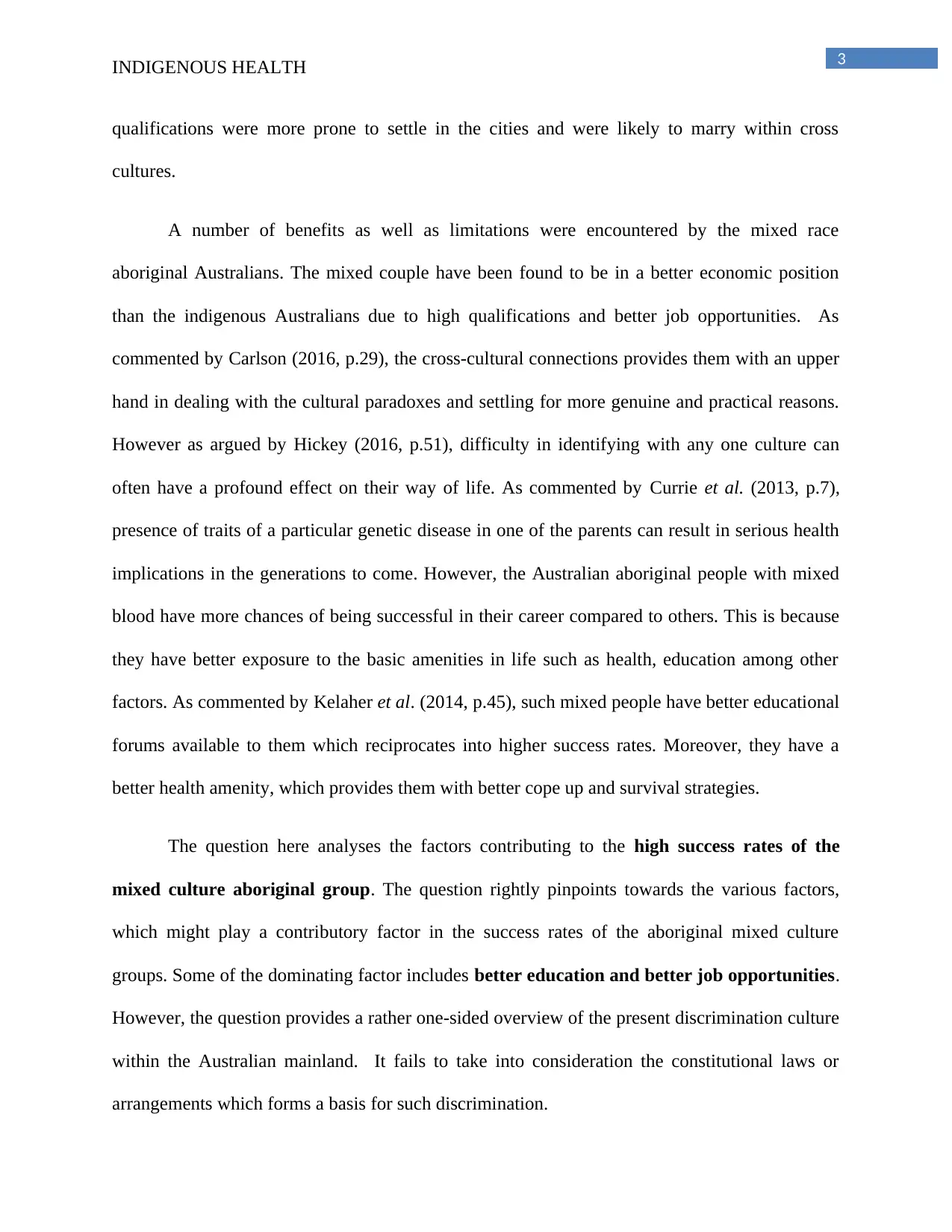
3INDIGENOUS HEALTH
qualifications were more prone to settle in the cities and were likely to marry within cross
cultures.
A number of benefits as well as limitations were encountered by the mixed race
aboriginal Australians. The mixed couple have been found to be in a better economic position
than the indigenous Australians due to high qualifications and better job opportunities. As
commented by Carlson (2016, p.29), the cross-cultural connections provides them with an upper
hand in dealing with the cultural paradoxes and settling for more genuine and practical reasons.
However as argued by Hickey (2016, p.51), difficulty in identifying with any one culture can
often have a profound effect on their way of life. As commented by Currie et al. (2013, p.7),
presence of traits of a particular genetic disease in one of the parents can result in serious health
implications in the generations to come. However, the Australian aboriginal people with mixed
blood have more chances of being successful in their career compared to others. This is because
they have better exposure to the basic amenities in life such as health, education among other
factors. As commented by Kelaher et al. (2014, p.45), such mixed people have better educational
forums available to them which reciprocates into higher success rates. Moreover, they have a
better health amenity, which provides them with better cope up and survival strategies.
The question here analyses the factors contributing to the high success rates of the
mixed culture aboriginal group. The question rightly pinpoints towards the various factors,
which might play a contributory factor in the success rates of the aboriginal mixed culture
groups. Some of the dominating factor includes better education and better job opportunities.
However, the question provides a rather one-sided overview of the present discrimination culture
within the Australian mainland. It fails to take into consideration the constitutional laws or
arrangements which forms a basis for such discrimination.
qualifications were more prone to settle in the cities and were likely to marry within cross
cultures.
A number of benefits as well as limitations were encountered by the mixed race
aboriginal Australians. The mixed couple have been found to be in a better economic position
than the indigenous Australians due to high qualifications and better job opportunities. As
commented by Carlson (2016, p.29), the cross-cultural connections provides them with an upper
hand in dealing with the cultural paradoxes and settling for more genuine and practical reasons.
However as argued by Hickey (2016, p.51), difficulty in identifying with any one culture can
often have a profound effect on their way of life. As commented by Currie et al. (2013, p.7),
presence of traits of a particular genetic disease in one of the parents can result in serious health
implications in the generations to come. However, the Australian aboriginal people with mixed
blood have more chances of being successful in their career compared to others. This is because
they have better exposure to the basic amenities in life such as health, education among other
factors. As commented by Kelaher et al. (2014, p.45), such mixed people have better educational
forums available to them which reciprocates into higher success rates. Moreover, they have a
better health amenity, which provides them with better cope up and survival strategies.
The question here analyses the factors contributing to the high success rates of the
mixed culture aboriginal group. The question rightly pinpoints towards the various factors,
which might play a contributory factor in the success rates of the aboriginal mixed culture
groups. Some of the dominating factor includes better education and better job opportunities.
However, the question provides a rather one-sided overview of the present discrimination culture
within the Australian mainland. It fails to take into consideration the constitutional laws or
arrangements which forms a basis for such discrimination.
Paraphrase This Document
Need a fresh take? Get an instant paraphrase of this document with our AI Paraphraser
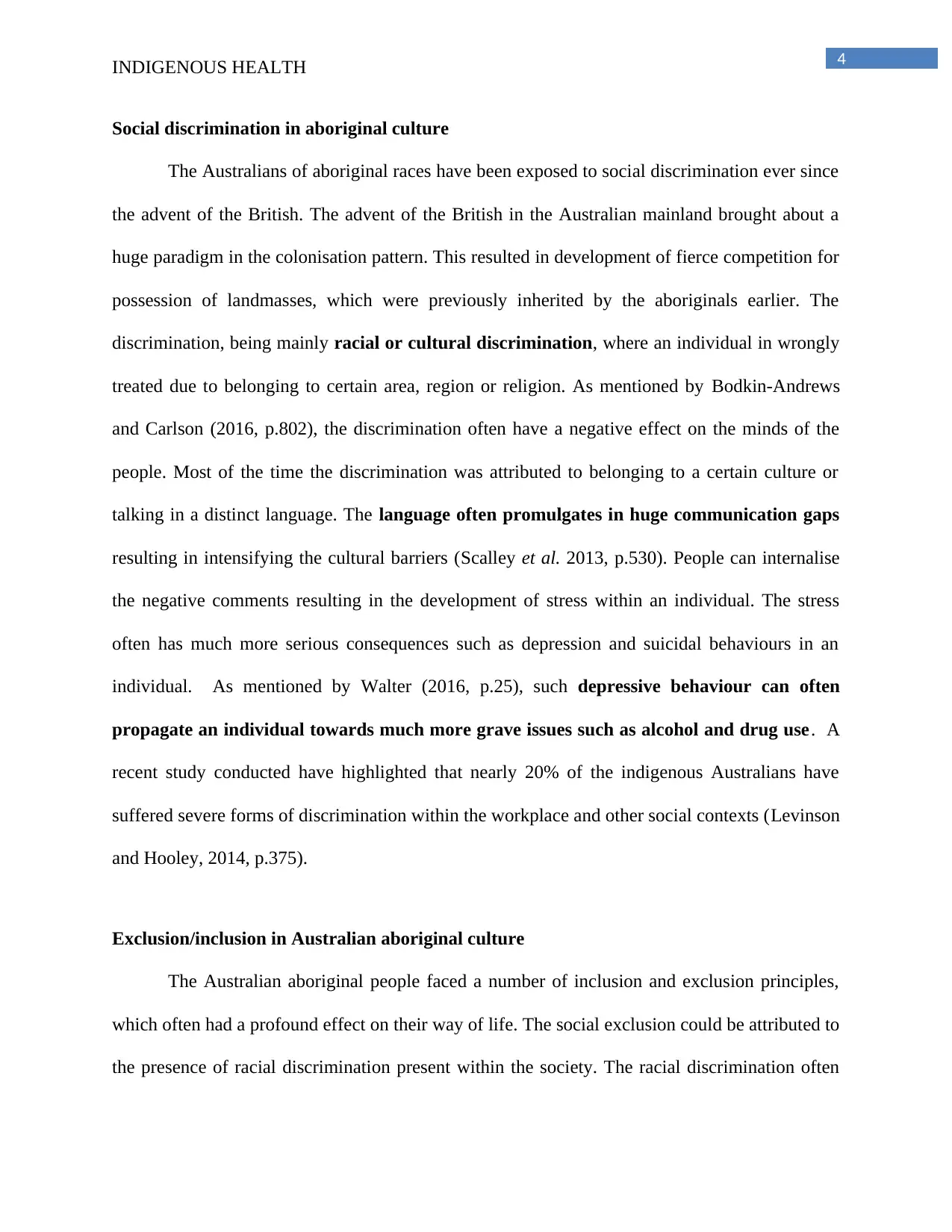
4INDIGENOUS HEALTH
Social discrimination in aboriginal culture
The Australians of aboriginal races have been exposed to social discrimination ever since
the advent of the British. The advent of the British in the Australian mainland brought about a
huge paradigm in the colonisation pattern. This resulted in development of fierce competition for
possession of landmasses, which were previously inherited by the aboriginals earlier. The
discrimination, being mainly racial or cultural discrimination, where an individual in wrongly
treated due to belonging to certain area, region or religion. As mentioned by Bodkin-Andrews
and Carlson (2016, p.802), the discrimination often have a negative effect on the minds of the
people. Most of the time the discrimination was attributed to belonging to a certain culture or
talking in a distinct language. The language often promulgates in huge communication gaps
resulting in intensifying the cultural barriers (Scalley et al. 2013, p.530). People can internalise
the negative comments resulting in the development of stress within an individual. The stress
often has much more serious consequences such as depression and suicidal behaviours in an
individual. As mentioned by Walter (2016, p.25), such depressive behaviour can often
propagate an individual towards much more grave issues such as alcohol and drug use. A
recent study conducted have highlighted that nearly 20% of the indigenous Australians have
suffered severe forms of discrimination within the workplace and other social contexts (Levinson
and Hooley, 2014, p.375).
Exclusion/inclusion in Australian aboriginal culture
The Australian aboriginal people faced a number of inclusion and exclusion principles,
which often had a profound effect on their way of life. The social exclusion could be attributed to
the presence of racial discrimination present within the society. The racial discrimination often
Social discrimination in aboriginal culture
The Australians of aboriginal races have been exposed to social discrimination ever since
the advent of the British. The advent of the British in the Australian mainland brought about a
huge paradigm in the colonisation pattern. This resulted in development of fierce competition for
possession of landmasses, which were previously inherited by the aboriginals earlier. The
discrimination, being mainly racial or cultural discrimination, where an individual in wrongly
treated due to belonging to certain area, region or religion. As mentioned by Bodkin-Andrews
and Carlson (2016, p.802), the discrimination often have a negative effect on the minds of the
people. Most of the time the discrimination was attributed to belonging to a certain culture or
talking in a distinct language. The language often promulgates in huge communication gaps
resulting in intensifying the cultural barriers (Scalley et al. 2013, p.530). People can internalise
the negative comments resulting in the development of stress within an individual. The stress
often has much more serious consequences such as depression and suicidal behaviours in an
individual. As mentioned by Walter (2016, p.25), such depressive behaviour can often
propagate an individual towards much more grave issues such as alcohol and drug use. A
recent study conducted have highlighted that nearly 20% of the indigenous Australians have
suffered severe forms of discrimination within the workplace and other social contexts (Levinson
and Hooley, 2014, p.375).
Exclusion/inclusion in Australian aboriginal culture
The Australian aboriginal people faced a number of inclusion and exclusion principles,
which often had a profound effect on their way of life. The social exclusion could be attributed to
the presence of racial discrimination present within the society. The racial discrimination often
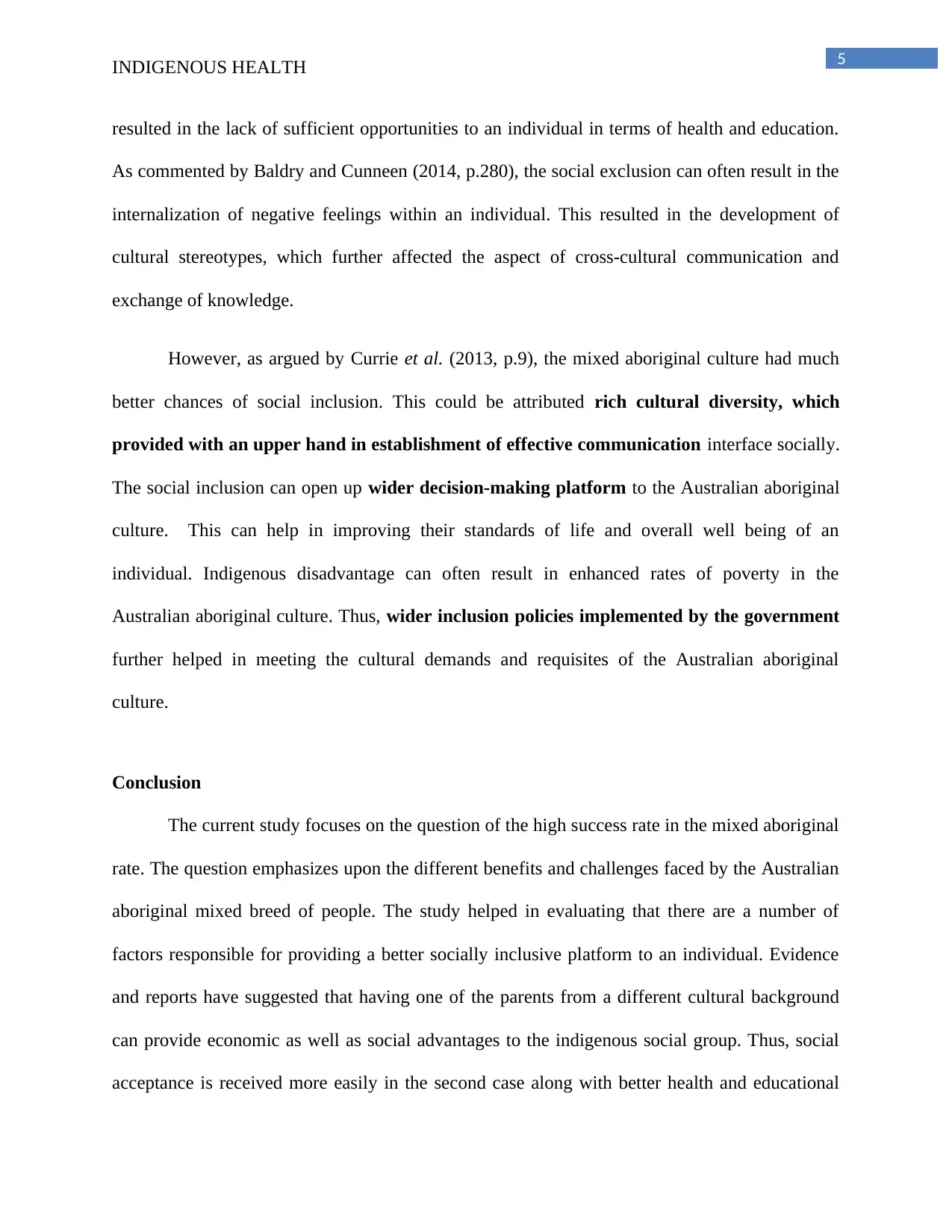
5INDIGENOUS HEALTH
resulted in the lack of sufficient opportunities to an individual in terms of health and education.
As commented by Baldry and Cunneen (2014, p.280), the social exclusion can often result in the
internalization of negative feelings within an individual. This resulted in the development of
cultural stereotypes, which further affected the aspect of cross-cultural communication and
exchange of knowledge.
However, as argued by Currie et al. (2013, p.9), the mixed aboriginal culture had much
better chances of social inclusion. This could be attributed rich cultural diversity, which
provided with an upper hand in establishment of effective communication interface socially.
The social inclusion can open up wider decision-making platform to the Australian aboriginal
culture. This can help in improving their standards of life and overall well being of an
individual. Indigenous disadvantage can often result in enhanced rates of poverty in the
Australian aboriginal culture. Thus, wider inclusion policies implemented by the government
further helped in meeting the cultural demands and requisites of the Australian aboriginal
culture.
Conclusion
The current study focuses on the question of the high success rate in the mixed aboriginal
rate. The question emphasizes upon the different benefits and challenges faced by the Australian
aboriginal mixed breed of people. The study helped in evaluating that there are a number of
factors responsible for providing a better socially inclusive platform to an individual. Evidence
and reports have suggested that having one of the parents from a different cultural background
can provide economic as well as social advantages to the indigenous social group. Thus, social
acceptance is received more easily in the second case along with better health and educational
resulted in the lack of sufficient opportunities to an individual in terms of health and education.
As commented by Baldry and Cunneen (2014, p.280), the social exclusion can often result in the
internalization of negative feelings within an individual. This resulted in the development of
cultural stereotypes, which further affected the aspect of cross-cultural communication and
exchange of knowledge.
However, as argued by Currie et al. (2013, p.9), the mixed aboriginal culture had much
better chances of social inclusion. This could be attributed rich cultural diversity, which
provided with an upper hand in establishment of effective communication interface socially.
The social inclusion can open up wider decision-making platform to the Australian aboriginal
culture. This can help in improving their standards of life and overall well being of an
individual. Indigenous disadvantage can often result in enhanced rates of poverty in the
Australian aboriginal culture. Thus, wider inclusion policies implemented by the government
further helped in meeting the cultural demands and requisites of the Australian aboriginal
culture.
Conclusion
The current study focuses on the question of the high success rate in the mixed aboriginal
rate. The question emphasizes upon the different benefits and challenges faced by the Australian
aboriginal mixed breed of people. The study helped in evaluating that there are a number of
factors responsible for providing a better socially inclusive platform to an individual. Evidence
and reports have suggested that having one of the parents from a different cultural background
can provide economic as well as social advantages to the indigenous social group. Thus, social
acceptance is received more easily in the second case along with better health and educational
⊘ This is a preview!⊘
Do you want full access?
Subscribe today to unlock all pages.

Trusted by 1+ million students worldwide
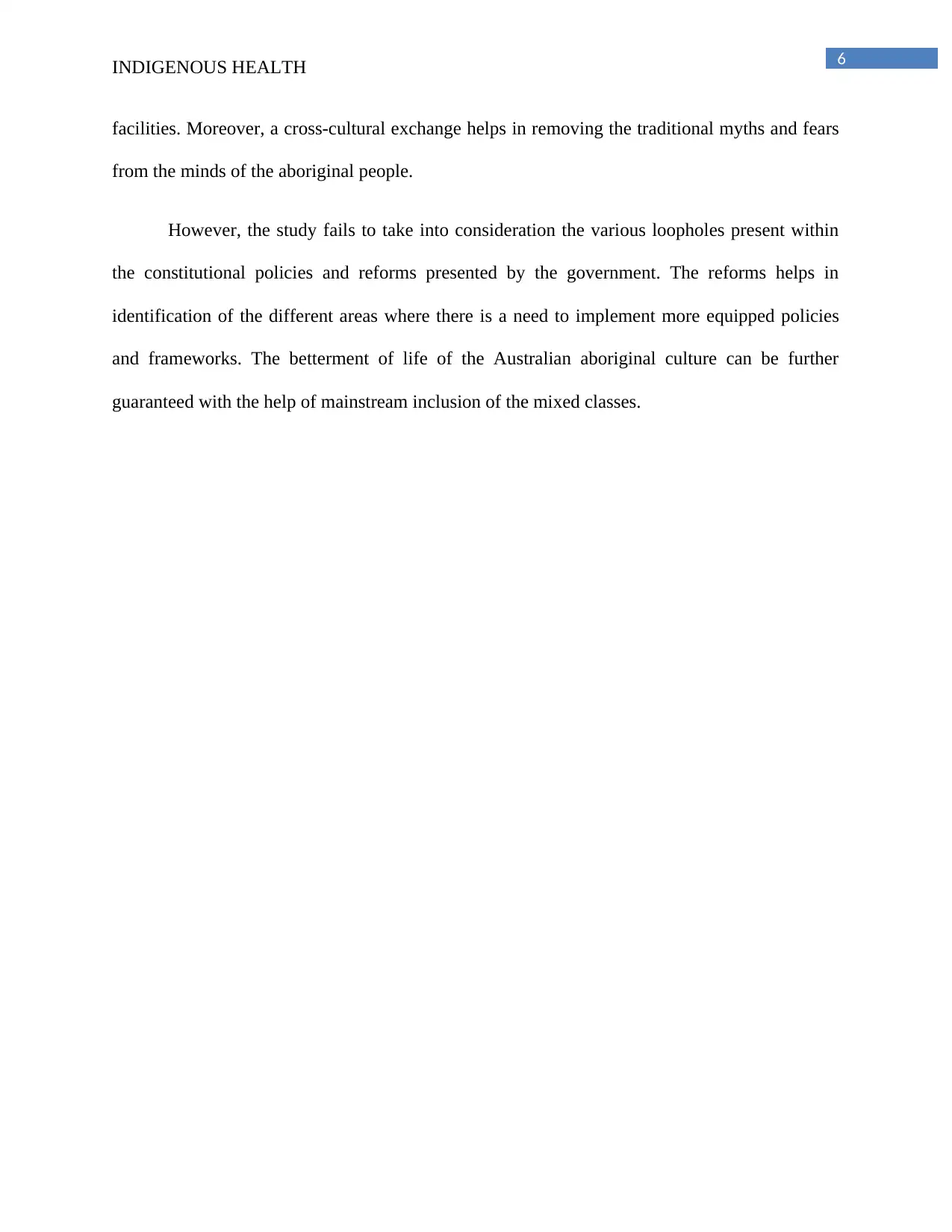
6INDIGENOUS HEALTH
facilities. Moreover, a cross-cultural exchange helps in removing the traditional myths and fears
from the minds of the aboriginal people.
However, the study fails to take into consideration the various loopholes present within
the constitutional policies and reforms presented by the government. The reforms helps in
identification of the different areas where there is a need to implement more equipped policies
and frameworks. The betterment of life of the Australian aboriginal culture can be further
guaranteed with the help of mainstream inclusion of the mixed classes.
facilities. Moreover, a cross-cultural exchange helps in removing the traditional myths and fears
from the minds of the aboriginal people.
However, the study fails to take into consideration the various loopholes present within
the constitutional policies and reforms presented by the government. The reforms helps in
identification of the different areas where there is a need to implement more equipped policies
and frameworks. The betterment of life of the Australian aboriginal culture can be further
guaranteed with the help of mainstream inclusion of the mixed classes.
Paraphrase This Document
Need a fresh take? Get an instant paraphrase of this document with our AI Paraphraser
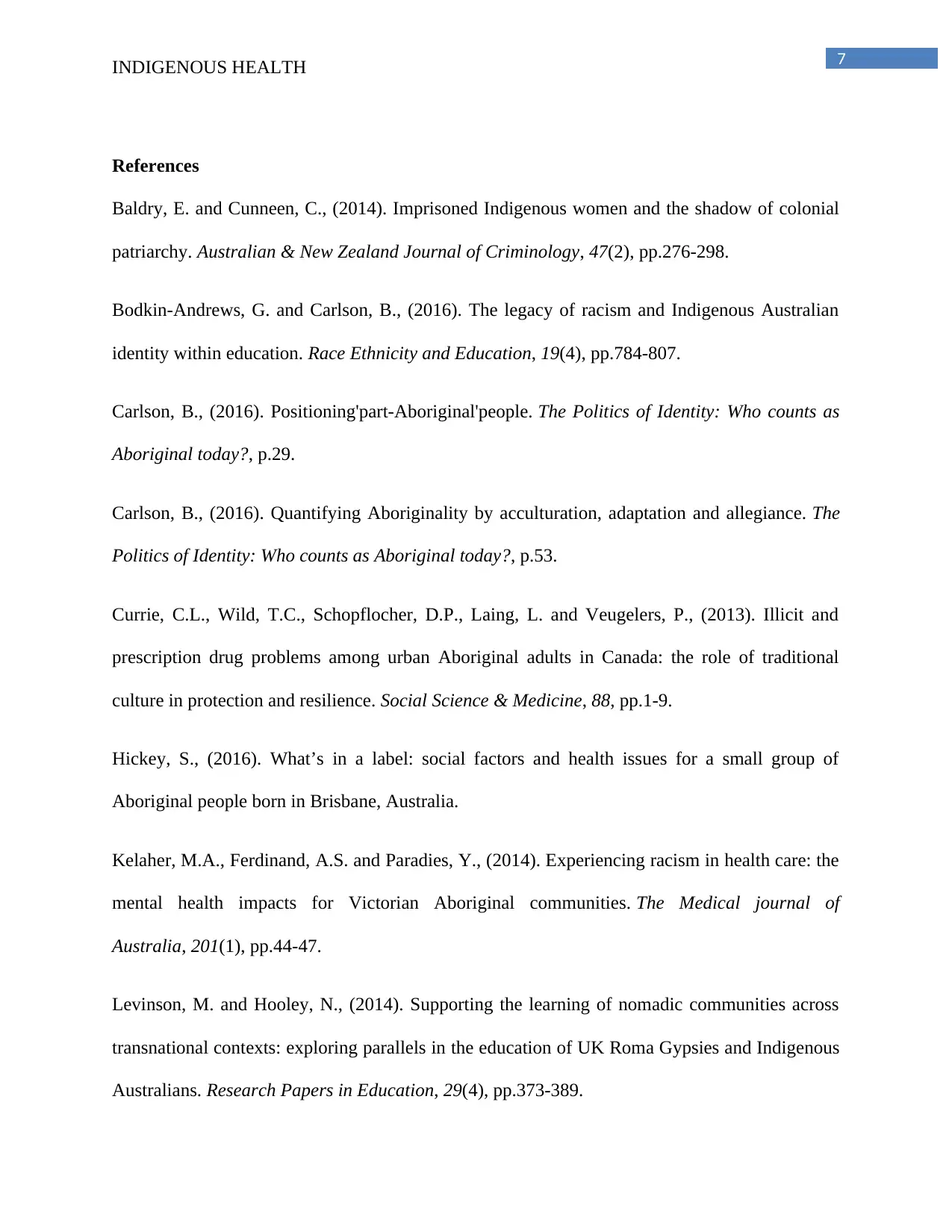
7INDIGENOUS HEALTH
References
Baldry, E. and Cunneen, C., (2014). Imprisoned Indigenous women and the shadow of colonial
patriarchy. Australian & New Zealand Journal of Criminology, 47(2), pp.276-298.
Bodkin-Andrews, G. and Carlson, B., (2016). The legacy of racism and Indigenous Australian
identity within education. Race Ethnicity and Education, 19(4), pp.784-807.
Carlson, B., (2016). Positioning'part-Aboriginal'people. The Politics of Identity: Who counts as
Aboriginal today?, p.29.
Carlson, B., (2016). Quantifying Aboriginality by acculturation, adaptation and allegiance. The
Politics of Identity: Who counts as Aboriginal today?, p.53.
Currie, C.L., Wild, T.C., Schopflocher, D.P., Laing, L. and Veugelers, P., (2013). Illicit and
prescription drug problems among urban Aboriginal adults in Canada: the role of traditional
culture in protection and resilience. Social Science & Medicine, 88, pp.1-9.
Hickey, S., (2016). What’s in a label: social factors and health issues for a small group of
Aboriginal people born in Brisbane, Australia.
Kelaher, M.A., Ferdinand, A.S. and Paradies, Y., (2014). Experiencing racism in health care: the
mental health impacts for Victorian Aboriginal communities. The Medical journal of
Australia, 201(1), pp.44-47.
Levinson, M. and Hooley, N., (2014). Supporting the learning of nomadic communities across
transnational contexts: exploring parallels in the education of UK Roma Gypsies and Indigenous
Australians. Research Papers in Education, 29(4), pp.373-389.
References
Baldry, E. and Cunneen, C., (2014). Imprisoned Indigenous women and the shadow of colonial
patriarchy. Australian & New Zealand Journal of Criminology, 47(2), pp.276-298.
Bodkin-Andrews, G. and Carlson, B., (2016). The legacy of racism and Indigenous Australian
identity within education. Race Ethnicity and Education, 19(4), pp.784-807.
Carlson, B., (2016). Positioning'part-Aboriginal'people. The Politics of Identity: Who counts as
Aboriginal today?, p.29.
Carlson, B., (2016). Quantifying Aboriginality by acculturation, adaptation and allegiance. The
Politics of Identity: Who counts as Aboriginal today?, p.53.
Currie, C.L., Wild, T.C., Schopflocher, D.P., Laing, L. and Veugelers, P., (2013). Illicit and
prescription drug problems among urban Aboriginal adults in Canada: the role of traditional
culture in protection and resilience. Social Science & Medicine, 88, pp.1-9.
Hickey, S., (2016). What’s in a label: social factors and health issues for a small group of
Aboriginal people born in Brisbane, Australia.
Kelaher, M.A., Ferdinand, A.S. and Paradies, Y., (2014). Experiencing racism in health care: the
mental health impacts for Victorian Aboriginal communities. The Medical journal of
Australia, 201(1), pp.44-47.
Levinson, M. and Hooley, N., (2014). Supporting the learning of nomadic communities across
transnational contexts: exploring parallels in the education of UK Roma Gypsies and Indigenous
Australians. Research Papers in Education, 29(4), pp.373-389.
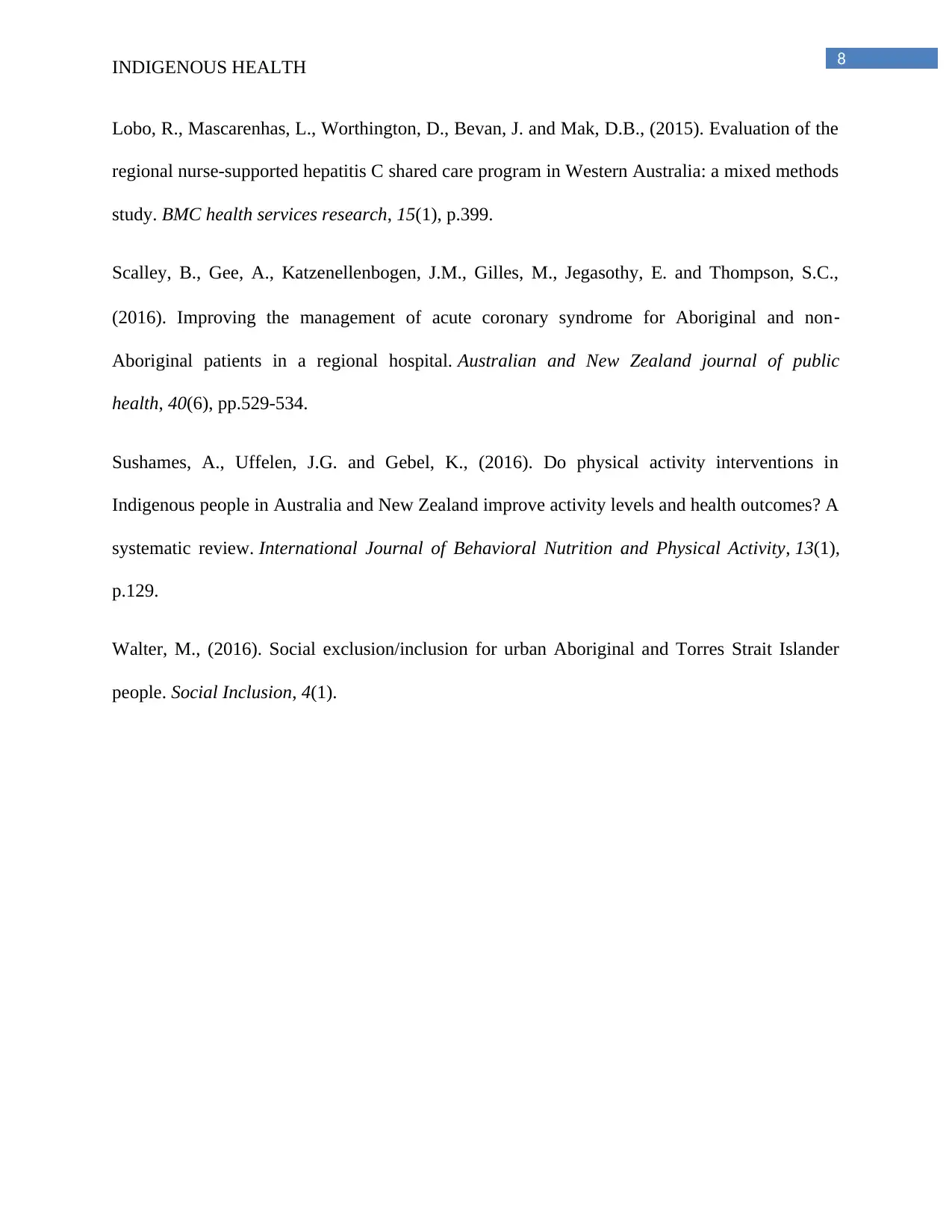
8INDIGENOUS HEALTH
Lobo, R., Mascarenhas, L., Worthington, D., Bevan, J. and Mak, D.B., (2015). Evaluation of the
regional nurse-supported hepatitis C shared care program in Western Australia: a mixed methods
study. BMC health services research, 15(1), p.399.
Scalley, B., Gee, A., Katzenellenbogen, J.M., Gilles, M., Jegasothy, E. and Thompson, S.C.,
(2016). Improving the management of acute coronary syndrome for Aboriginal and non‐
Aboriginal patients in a regional hospital. Australian and New Zealand journal of public
health, 40(6), pp.529-534.
Sushames, A., Uffelen, J.G. and Gebel, K., (2016). Do physical activity interventions in
Indigenous people in Australia and New Zealand improve activity levels and health outcomes? A
systematic review. International Journal of Behavioral Nutrition and Physical Activity, 13(1),
p.129.
Walter, M., (2016). Social exclusion/inclusion for urban Aboriginal and Torres Strait Islander
people. Social Inclusion, 4(1).
Lobo, R., Mascarenhas, L., Worthington, D., Bevan, J. and Mak, D.B., (2015). Evaluation of the
regional nurse-supported hepatitis C shared care program in Western Australia: a mixed methods
study. BMC health services research, 15(1), p.399.
Scalley, B., Gee, A., Katzenellenbogen, J.M., Gilles, M., Jegasothy, E. and Thompson, S.C.,
(2016). Improving the management of acute coronary syndrome for Aboriginal and non‐
Aboriginal patients in a regional hospital. Australian and New Zealand journal of public
health, 40(6), pp.529-534.
Sushames, A., Uffelen, J.G. and Gebel, K., (2016). Do physical activity interventions in
Indigenous people in Australia and New Zealand improve activity levels and health outcomes? A
systematic review. International Journal of Behavioral Nutrition and Physical Activity, 13(1),
p.129.
Walter, M., (2016). Social exclusion/inclusion for urban Aboriginal and Torres Strait Islander
people. Social Inclusion, 4(1).
⊘ This is a preview!⊘
Do you want full access?
Subscribe today to unlock all pages.

Trusted by 1+ million students worldwide
1 out of 9
Related Documents
Your All-in-One AI-Powered Toolkit for Academic Success.
+13062052269
info@desklib.com
Available 24*7 on WhatsApp / Email
![[object Object]](/_next/static/media/star-bottom.7253800d.svg)
Unlock your academic potential
Copyright © 2020–2025 A2Z Services. All Rights Reserved. Developed and managed by ZUCOL.





